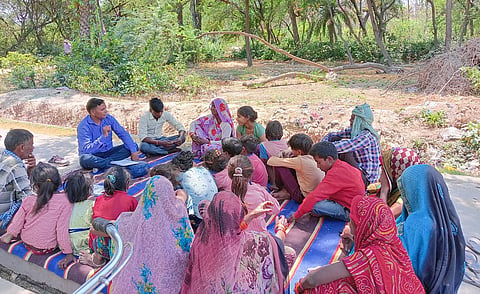World Environment Day 2025: Climate change is rewriting childhood in Lakhimpur Kheri’s forest villages
As the sun was setting over Ajmatpur village, Anantram, a local field worker was heading home after his day’s rounds. “I was walking back to compile my field notes when it happened,” he recalls. “A wild boar charged out of nowhere. I tried to defend myself, but was caught off guard. The next thing I knew, I was on the ground, bleeding and frantically calling for help.”
Anantram survived. But his story is just one in a growing number of recent encounters between humans and wild animals in Behjam block of Lakhimpur Kheri. What was once an occasional shock has now become disturbingly routine in the forest-fringe areas of Uttar Pradesh. At the heart of this shift lies a larger crisis — climate change, and its domino effect on thinning forests, and animals encroaching human territories in search of food.
When forests thin
The forests of Lakhimpur Kheri, part of the Terai belt, were once lush and teeming with biodiversity. They are now under relentless pressure. Human encroachment, deforestation, and an expanding sugarcane economy are eating into the natural habitat. But the degradation of these forests is not an isolated issue — it is part of a broader climate crisis. As forest cover shrinks, so does the land’s ability to absorb carbon, regulate local climate, and recharge groundwater. Rising temperatures, erratic rainfall, and longer dry spells are both a consequence and a cause of deforestation, creating a vicious cycle that leaves ecosystems fragile and wildlife desperate.
Displaced animals, in search of food and water, now frequently wander into villages, triggering conflicts that didn’t exist a generation ago.
Childhood under siege
In the village of Kachiyani, three children were recently attacked by a wolf. “It used to be rare to see wild animals near our home,” says Sita (name changed), an eighth-grade student. “Now, it happens almost every day.”
The consequences go far beyond fear. The nearest school is over three kilometres away, and with wild animal sightings becoming more common, parents are increasingly concerned and reluctant to let children make the journey alone. “Our children are trapped indoors,” said a concerned mother. “They are missing school, missing play, and missing their childhood.”
Ten-year-old Suneeta (name changed), from the neighbouring village of Paila, says what many others feel but cannot express: “I want to go to school and play with my friends. But a child was attacked here, and in another village, people died in tiger attacks.”
What was once a normal rural childhood — filled with fields, friends, and fresh air — has been replaced with anxiety and confinement.
Ecological paradise in peril
Lakhimpur Kheri is not just the largest district of Uttar Pradesh — it’s also home to the Dudhwa National Park, a critical wildlife corridor for tigers, leopards, swamp deer, and more. But the district’s expanding population, along with its booming sugarcane cultivation, is pushing these forests to the brink. After harvest, the open sugarcane fields become exposed corridors, making it easier for wild animals, especially wild boar and big cats, to stray into human spaces.
The link to climate change is undeniable. Forest loss contributes to rising temperatures, while rising temperatures degrade the forests further. What follows is a cascade: disrupted animal behaviour, failed crops, water scarcity, and heightened vulnerability for communities, already struggling with poverty and inadequate infrastructure.
Open defecation increases risk
Open defecation in forest villages often increases the risk of human-animal encounters by attracting wildlife to human settlements and creating vulnerable situations for people in forested areas. When people defecate in the open, they become more vulnerable to animal attacks, especially from predators like tigers and leopards.
According to a 2010 Ministry of Urban Development report, Lakhimpur was ranked the second lowest in sanitation among Indian cities. As the more recent data from the NITI Aayog District Scorecard suggests, more than one-third (34 per cent) of the population are yet to use the improved Sanitation Facility in Lakhimpur Kheri (which is poorer than the state average of 31.2 per cent).
Though the widespread dependence on open defecation has reduced over the past one and half decades, the practice still prevails and subsequently leads to increased exposure to wildlife which often ventures into such areas in search of food.
A call for climate-conscious action
Experts suggest that the situation demands a multi-pronged response. We need to recognise that what we’re witnessing is not just human-wildlife conflict, but a direct fallout of ecological collapse and climate stress.
They further point out that local communities must be supported with knowledge on animal behaviour, climate adaptation, and safety. Establishing collaborative monitoring systems between villagers and forest departments can help track wildlife movement and issue timely alerts. Afforestation drives and restoration of forest patches can reduce pressure on wildlife to venture into human spaces. Equally important are behaviour change programmes around waste and sanitation practices that often draw animals into villages.
But at the same time, we should also remember that children must be put at the centre of any such intervention, so that they can enjoy the right to education, recreation, and a life free from fear. Establishing safe routes to schools, protective physical barriers, and emergency response systems should be immediate priorities.
Lessons from the edge
What is happening in Lakhimpur Kheri is not unique. Across India, forests are thinning, climate patterns are shifting, and wildlife is increasingly entering human terrain. But this district also offers a template for how to respond—with community engagement, habitat restoration, and child-focused resilience planning.
Climate change may be global, but its impact is deeply local—and deeply personal. In Lakhimpur, it is changing the meaning of normal life for everyone, including children. And unless urgent action is taken, that change may become permanent.
Jaya Singh is Programme Head, CRY – Child Rights and You (North)
Views expressed are the author’s own and don’t necessarily reflect those of Down To Earth


